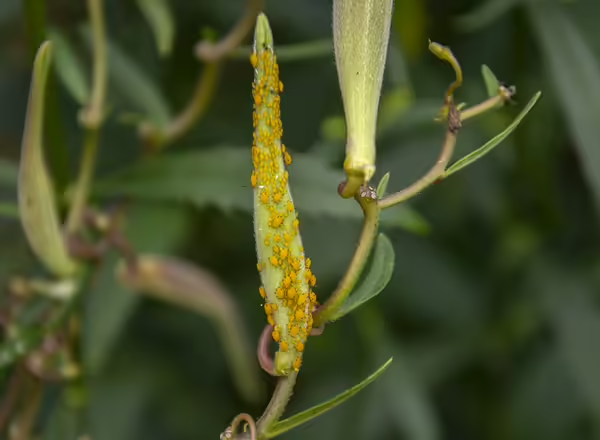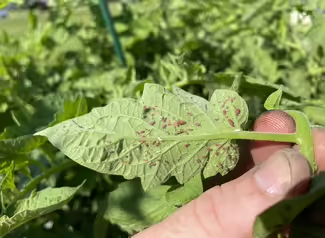
Aphids may be green, black, brown, red, pink, or some other color. These pear-shaped insects are slow moving and range in size from 1/16 to 1/8 inch long. They have conspicuous slender antennae and near the rear end of the abdomen there are two tubes called cornicles. Some may have transparent wings.
Aphid Habit
Dense colonies of aphids may be found along stems or on the underside of a leaf. They are drawn to succulent new growth. Several generations may occur and populations can build up quickly.

Aphid Damage
Aphids are sucking insects which draw great quantities of sap, causing leaves and stems to become distorted. This distorted growth may be mistaken as herbicide injury. Some plant sap is excreted as honeydew, which makes the plant sticky. Sidewalks, cars, and patio furniture may become wet with honeydew. A sooty mold often grows in the honeydew and blackens stems, leaves and any other surface. Aphids may transmit plant pathogens.
Aphid Control
Non chemical: Wash off aphids with a steady stream of water. Avoid heavy applications of nitrogen fertilizer which can encourage succulent plant growth. Natural predators such as lady beetles and aphis lions feed on aphids but may not always provide adequate control.
Chemical: Contact your local Extension office for current pesticide controls.
Life Cycle of Aphids
The green peach aphid and other aphids tend to overwinter in the egg stage mainly on stone fruits such as plums and peaches while potato aphids overwinter on roses. The aphids attack pepper fields mainly in midsummer. The cabbage aphid is a problem in most brassica, especially on Brussels sprouts. In pumpkins, squash, and other cucurbits they suck juices from the leaves and fruits and transmit virus mosaic pathogens. The pathogen causes a serious malformation on leaves of pumpkins and summer squash leading to poor yield and reduction in fruit quality.
Management of Aphids
Gardeners: Spray colonies with water to remove aphids from the leaves in a small garden. Ladybird beetles and other natural predators feed on aphids so do not spray with insecticides that can kill ladybird beetles. Also use fine netting row covers.
Commercial: For a heavy aphid infestation in a commercial field, use insecticides. Contact your county Extension office for current pesticide controls. or refer to Midwest Vegetable Guide.

